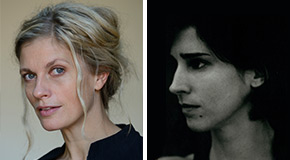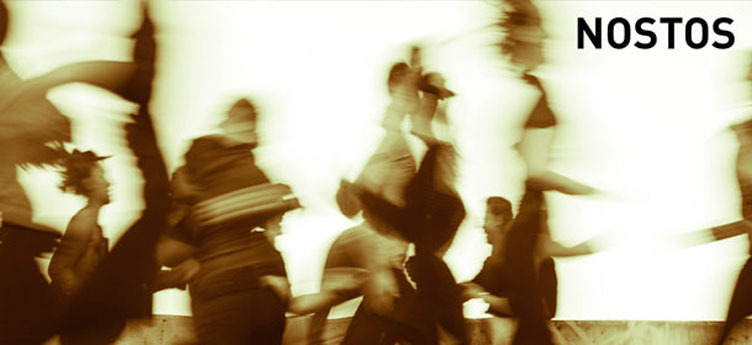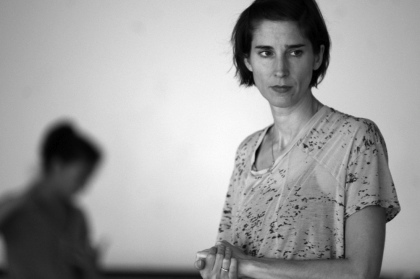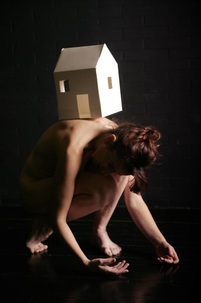|
Lesley Telford’s Spooky Action makes an elegant leap from scientific theory to theatrical performance
KAIJA PEPPER SPECIAL TO THE GLOBE AND MAIL PUBLISHED OCTOBER 17, 2019 Quantum entanglement refers to two particles that share the same properties and, no matter how great the distance between them, a change to one instantaneously affects the other. The mere act of observing one impacts its partner. Dubbed “spooky action at a distance” by Albert Einstein, it’s mind-boggling stuff. Lesley Telford’s Spooky Action, which opened at Vancouver’s Firehall Arts Centre on Wednesday, was inspired by this complicated scientific theory, one that is challenging to fully process even for physicists. Yet, with her team of artistic collaborators, Telford makes the considerable leap from conceptual to theatrical with elegance and wit. Telford uses science as a jumping-off point only, tackling entanglement at a human level. Her finely wrought choreography for five dancers has them skittering and skating around the stage (they wear socks, which helps the flow) in various configurations, hypersensitive to each other and the space around them. Their articulated bodies, moving with freedom and force, often seemed more like particles of colour and motion than flesh-and-blood human beings. Brandon Alley, until recently a member of Ballet BC, has one solo where he circles around his own body with flailing arms and legs, ending up spinning in place, low to the floor, a force of nature. The most seasoned of the dancers, he brings a welcome hint of drama and emotional warmth to some of his movement. The five performers' bodies, moving with freedom and force, often seem more like particles of colour and motion than flesh-and-blood human beings. SteŽphanie Cyr’s precisely articulated feet and lusciously arched torso reminded me of Telford’s own past appearances onstage (her performing career spans Les Grands Ballets Canadiens, Compania Nacional de Danza and Nederlands Dans Theater). Collaboration, a tenet of Telford’s Vancouver-based Inverso Productions, is an apt approach here, adding layers of visual and aural entanglement. Lighting designer Alan Brodie favours the heightened effects of deep shadow and blazing lights to obscure or reveal the dancers. Composer James Meger’s variously lush or minimalist score floats in and out, his palette of hums, plucked chords and vibrations contributing to, but never dominating, the creative dynamics. Voice-overs of spoken text were harder to integrate; text always is. Words and movement communicate differently, and when each is intensely styled and loaded, it can be hard to focus on both at the same time. Interdisciplinary artist and performer Barbara Adler used language wryly and colourfully, veering from existential statements such as “The world was happening to me” to intimate domestic observations: “Butter melts in a hot pan. I’m hungry. Noted.” I had to let the text go in order to process the dance more freely. With Spooky Action, Telford hits her stride as a choreographer. The idea of entanglement hovers mysteriously in the air, creating a fresh paradigm in which to view the dance. Spooky Action continues at the Firehall Arts Centre until Oct. 19. © Copyright 2019 The Globe and Mail Inc. All rights reserved. 351 King Street East, Suite 1600 Toronto, ON CanadaN1 Phillip Crawley, Publisher
0 Comments
Molly Gray/ Vancouver Arts Review, December 6, 2017
“In the knowledge sharing, jargon pillaging world of the internet, different disciplines often reference one another. But even by today’s standards of cross-pollination, blending Quantum theory with dance is novel. Not to be deterred by a little impenetrably complex scientific theory, in “Spooky Action Phase One”, Lesley Telford and Inverso use quantum physics as their conceptual seed. The premise that so intrigued them was the discovery that on a quantum level, particles not physically connected could exert influence on one another. For the creative team this theory sparked further existential examination, how can one soul influence another? Are human lives inexplicably linked beyond physical connections? The resultant performance was just as intriguing as the premise. The piece was beautifully choreographed and gracefully executed. The ebb and flow of energy from one dancer to another was tantalising. The connectivity of the dancers was not exhibited through straight mimicry or synchronisation but something subtler. Motifs of movement passed from one dancer to another, syncopated, evolving with the quirks and individuality of each new recipient. An estranged shadow of the original movement echoed through the performance. Some of the most powerful moments were when the dancers moved as a conglomerate, with energy rippling from one dancer to the next, a congealed undulating throng.” Naomi Brand/ The Dance Current, May 16, 2017
“It’s no easy task to communicate specific ideas through contemporary dance. It can be tricky to make the abstract movement of Gumby-like bodies live up to the lofty themes in a choreographer’s imagination. Luckily, in Lesley Telford’s latest creation, she has chosen both her topic and her collaborators well. …The piece is an interdisciplinary collaboration with poet Barbara Adler, who sets up the work by comically explaining the phenomenon of quantum entanglement to the audience (with the help of Wikipedia, of course) and then clarifies that the piece is, in fact, not about physics at all but inspired by it. …Adler’s introduction, combined with her beautifully handcrafted, tiny books of poetry (distributed to the audience during intermission), preps the audience by situating us in a world that is equal parts poetry and science. The miniature books are printed on graph paper and, while they are not detailed to the level of the particle, they draw my focus to imagery held in the recesses of memories from high school science class. This metaphor of the experiment, with both known and unknown elements, did well to place the audience in our role as observers of the microscopic. …Ultimately, it’s a work about relationships – how things (human or other) interact, organize and coexist. The dancers portrayed these concepts not in a literal ways but through poetic imagery supported by a distinctive lighting design by Kyla Gardiner. At one point the dancers group together, orbiting a series of lights radiating outward from a single nucleus in a complex geometric pattern projected onto the white floor. Later, one dancer again orbits another, who is engaged in a sequence of expansive movement, one acting as the observed particle to another. Throughout the work, relationships of connection and influence are seen (and heard), and near the end the metaphorical thread that connects us all is made visible when an elastic is pulled across the stage. Dancers then moved over, under and around, entangling themselves in the line that divided the space left to right. There are elements of Telford’s dance vocabulary that offer familiar and hints of her influence, such as Crystal Pite and Nederlands Dans Theater. But in this work her musical phrasing is the most arresting element. The movements are strung together with rhythmic diversity, punctuated acutely with the consideration of a composer or a beat poet. The performers …are fiercely talented dancers and their elastic bodies exhibit a remarkable ability to shift swiftly between qualities and initiation points. The objective vantage point of the piece’s scientific inspiration paired well with the humanity and sensitivity of Adler’s poetry and her live delivery from offstage. Her voice was familiar and friendly in contrast to the highly technical and virtuosic, though unaffected dancing.” The Georgia Straight/ by Janet Smith on April 19th, 2017 at 12:56 PM
One of the clearest definitions of quantum entanglement—a phenomenon Albert Einstein dubbed “spooky action at a distance”—can be found in a vampire movie. In Jim Jarmusch’s Only Lovers Left Alive Tom Hiddleston’s depressed rock-star bloodsucker explains it this way to Tilda Swinton’s Eve, his centuries-long partner: “When you separate an entwined particle and you move both parts away from the other, even at opposite ends of the universe, if you alter or affect one, the other will be identically altered or affected.” In fact, it was by watching the dark love story that Vancouver dance artist Lesley Telford learned about quantum entanglement—in which particles are so closely connected that they cannot act independently of one another, no matter how much space lies between them. She became fascinated not just with the scientific possibilities of the concept but with the romantic ones. It’s an idea she explores in a new work, named—what else?--Spooky Action at a Distance. “I thought, ‘What a great metaphor,’ ” the choreographer tells the Straight over sushi before heading into a Dance Centre studio. “It’s the idea of quantum entanglement and how that could relate to human entanglement.…It’s really a metaphor for human interactions.” First, though, as is so often the case with Telford, she needed to form those ideas into words. So she approached poet Barbara Adler to talk about the phenomenon, and then to have her build poetry around it—text that the writer will perform live in Telford’s first full evening of work here. “Barbara talked a lot about how you feel this resonance with people that have been in your life, and how it’s tied into romantic connections and love stories,” Telford explains. “As we dig into it, it’s become less about that and more of an underlying vibration in the work; it feels like we’ve gone beyond that starting point.…I feel like she has a way of making it so down-to-earth and it’s given us so much food to work with. Are we in control of the universe or is it in control of us?” Spooky Action at a Distance, a work for seven dancers, ends up being a string of duets that weave—entangle—into other duets. Under the banner of her company, Inverso, it joins two other pieces on a solo program called Three Sets/Relating at a Distance that features poetry-driven works. Telford, an alumna of Nederlands Dans Theater and Madrid’s Compañía Nacional de Danza, has now returned to her hometown and is in the midst of an artist’s residency at the Dance Centre. She is already in demand here: along with this solo evening, she’s just coming off a creation at Ballet BC for its Program 2, and she’s done choreography for Pi Theatre’s remount of the play Long Division. In the duet My tongue, your ear, she plays Nico Muhly’s haunting, angular viola piece Etude 1A off excerpts of Polish poet Wisława Szymborska’s ironic portrayal of parting, “The Tower of Babel”, and If is a trio that features an Anne Carson poem. In Spooky Action, it was Adler who really anchored her ideas and helped her grab onto an intangible concept, Telford says. But in the other two short pieces, poetry was the impetus for her explorations. “The danger in dance is it becomes so studied; it can square off into music,” Telford explains of her love of using poetry, “so those rhythms [of speech] really sparked ideas about how we access movement.” Non-physics majors in the audience will be relieved to hear that in Spooky Action, as in the other two works that show Telford’s range of creation over the past decade, it’s not required to fully comprehend the complex concepts that inspire her choreography. It can be simply enough to enjoy innovative choreography that feels like it’s grounded in something deep, intricate, meaningful, and sometimes a bit strange. “I kind of hope that people don’t feel it’s necessary to understand it all,” says Telford. “It just helps me find a reason to make movement.” Lesley Telford’s Three Sets/Relating at a Distance is at the Scotiabank Dance Centre from Thursday to Saturday (April 20 to 22). Performance Place and Politics by Peter Dickinson
"...The Paris Sessions, which together with Lesley Telford's Only who is left, was the highlight of the evening for me." "...Telford also knows how to mass dancers' bodies on stage. But if Pite's work here is about harmonious flow, Telford leans (quite literally) toward the off-axis. In Only who is left, she sends her dancers out in matching shimmery shifts and has them strut and preen and pose in a horizontal line like so many Atlases come to life from a Greek frieze. Later she'll clump the dancers together and have them jerk and stutter step their heels noisily into the floor as they move as a unit across the stage, the thoroughly ungraceful and off-beat movements providing a compelling counter-image to how dancers are expected to move and sound. The corralling or herding of bodies in Telford's work is compounded even further by the fact that at one point Constant appears with a bull horn; he mostly just whistles into it whimsically. But the device's appearance, especially when read alongside the epigraph Telford includes in the program, reminds one that as is so often the case these days when bodies gather together in public--and often in protest--there is almost always someone who wants to disperse them. For now, however, let's just celebrate the fact that Telford and Pite have both decided to make Vancouver their dance homes, and that these two talented home-grown choreographers are sharing their gifts with the city's next generation of dancers." "Standouts include short pieces from some acclaimed names. Lesley Telford, back in Vancouver (after stints at Les Grands Ballet Canadiens, Compañía Nacional de Danza, and Nederlands Dans Theater), is an exciting voice on the scene who's crafted work for Ballet BC and Arts Umbrella. I love the way her detailed My tongue, your ear seems to deliriously defy time and space, with bodies leaning and spinning off their centre of gravity or moving backward like some higher being is reversing the clock. Here, she creates a dreamlike duet for former Ballet BC bright light Darren Devaney and Maya Tenzer, set to Nico Muhly’s haunting, pulsing Etude 1A, featuring angular viola, and the disjointed excerpts of Polish poet Waslawa Szymborska’s ironic portrayal of parting, “The Tower of Babel”."
by Janet Smith on February 13th, 2016 at 2:54 PM Ballet B.C.’s season opener No. 29 impresses with challenging works and new dancers | Georgia Straight, Vancouver’s News & Entertainment Weekly.
“The magic that Telford achieves with her 11 dancers is something akin to suspended time, like we enter “an instant”, then rewind, then freeze, then enter it again from a different perspective. Dancers hurtle backwards like they’re being pushed by some unseen force, then fall on the floor and lie still. New corps member Emily Chessa, in one intense scene, rushes toward something unseen then runs backward, again and again, drawn and repelled by powers we can’t fully understand. Telford pushes the dancers off axis, bends them over backwards, and sends them leaping in reverse. Amid them all wanders the always magnetic Rachel Meyer, sometimes stepping through their frozen, fallen bodies, as if she is somehow looking at what could happen or what could have happened. Heady stuff, yes, but strange, haunting, and thought-provoking, the mood helped, as ever, by James Proudfoot’s atmospheric lighting and shadows.” by Janet Smith on November 7th, 2014 at 5:52 PM Ballet BC’s No. 29 opens the 14/15 season with superb dancing | Vancouver Observer.
“Vancouver-born choreographer and dancer Lesley Telford’s An Instant is based on Wislawa Szymborska’s poem Could Have heard during the piece recited by Amos Ben Tal . The most modern aesthetic of the night, with close to the ground choreography, weight sharing duets, relaxed arms and hands and fall and recovery motion, the movement had a Pina Bausch-like aesthetic. Beautifully costumed by Kate Burrows with gorgeous lighting by James Proudfoot, the dancers tell their stories of isolation with artistry. Rachel Meyer and Emily Chessa, in particular, use their bodies with abandon to share their inner voices. A fabulous end to the dance leaves the audience with a lovely parting memory." by Andrea Rabinovitch Ballet B.C. pushes to the breaking point with No. 29. Interview with Janet Smith / Georgia Straight30/10/2014
Chutzpah! 2013: Lesley Telford’s Brittle Failure.
“…As for the dancing, I was most taken by the two duets–between Ansa and Archer, and then between Ansa and Oliviera–that conclude the piece. The first is by far the more physical, the strength of one partner’s fragile hold tested by the counter-weight of the other’s oppositely straining body, Ansa and Archer enacting their own “brittle failure,” which as the program notes remind us “is a technical term used to define the conditions under which solid materials fracture under pressure.” Then, in the final duet between Ansa and Oliviera, Telford seems to be asking under what conditions might those broken pieces be put back together, a final origami abode placed gingerly between one foot of each of the dancers as they slowly pivot around it and also raise it delicately aloft, careful now not to crush what real or imagined space binds them together: 'safe as houses'.” Peter Dickenson, Performance, Place, and Politics, Vancouver, 10/02/2013 Lesley Telford and Itzik Galili bring their unique choreographic voices to the Chutzpah Festival
“It says something that despite the strong presence of the striking scenography, it’s the pure dance sections that draw your attention most throughout Brittle Failure. Through various fraught couplings, Telford seems to be getting at the fragility of relationships and the way they can break under pressure.” “There is no doubt Telford has a clear, fluid, and utterly unique voice when it comes to choreography.” Georgia Straight / Janet Smith, Vancouver, 8/02/2013
"The festival Madrid en Danza closed last Sunday with what was undoubtedly its best creative work in dance: Paredes de Papel (also known as Brittle Failure). Working with a very thoughtful and sustained balance between the intellectual and the choreographic material, Paredes … demonstrates how aesthetic awareness, maturity in scenic knowledge and the right selection of interpreters, are the basic ingredients for a successful work of ballet or contemporary dance and not mere platitudes. The choreographer adapted with ease to a space as unique as it was compromised: the heritage of Corral de las Comedias, and in fact used the lights, hollows and perspective of the space to incorporate the installation by the Japanese artist Yoko Seyama into a harmonious whole."
* translated from EL PAIS/ Roger Salas, Madrid, 26.11.2012, Herencia bajo el techo a dos aguas 60 minutos de caos y 10 de intensa emoción :: Ocio y cultura :: Guía Cultural
“The proximity and concentration of the three dancers, spoken interventions, and set design, collaborate and complement each other to move the abstraction to something more tangible. Here there is communication between the characters, yes there is serenity, introspection, moments of calm and even enjoyment. “Paredes de Papel” does come to a conclusion and the final act is a visual and emotional discovery that manages to connect with the audience and move them. Something that, one supposes, any performance aims for, as avant-garde as it may be.” *translated from Eva Catalán, Guia Cultural, Madrid, 26/11/2012 "The Canadian Lesley Telford starts this triple-bill with Everything Might Spill, giving extra meaning to the title with a tense and erratic choreography, startling and robotic. The piece is about the fragile balance and illusion of real stability (which is life, is it not?). …the shadows and the overall tone of the physical score were alive and moving. The body, captivated within the interior of a cylindrical form, connects to outside possibilities through imagined movement, projected by four slide projectors in a beautiful cinematic exercise which complements this turbulent kinetic flight."
*translated from Notodo.com/ David Cano, Teatro de Madrid, 21.03.2011 "…It is striking that many of the creators made smart and inventive use of elements such as light and decor. Working with Kylian and Lightfoot/Leon (masters in the play with stagecraft) clear traces have been left behind. The ideas of the dancers come to the foreground using the wings and different elements of the stage or, for example, when the light represents a cross on the floor. The line game on the floor certainly brings another element to the piece of Lesley Telford, ‘Intersection‘. Dancer Kenta Kojiri stands as a solitary individual on an empty stage and moves searchingly, sometimes in long lines or small and isolated. A large group of people comes in, following the diagonal lines on the ground while they simply walk past. It makes Koriji’s movements only more powerful…"
*translated from Den Haag Centraal/by Ilse Van Haastrecht, 25.01.2008, Switch’08 shows work from brave NDT’ers "…the ballet ‘Intersection‘ by Lesley Telford shows with beautiful movement how Kenta Kojiri remains in a world where humans live alongside each other without making contact. In his longing for meaning and a need for connection he is led into a crossroad of movement."
*translated from Volkskrant, Switch’08, 20.01.2008 |
|




